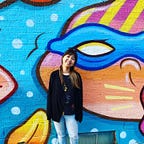Process | Jumping In
How do I start a year-long, self-directed journey? How do I start my thesis?
Coming back from a challenging big tech internship, I am excited to be coming back to the world of academia this semester. To me, the world of academia means I can do what is best for the world and try my best to push the idea as far as I can. It means that I can fail as long as I stay innovative and motivated. But it also means I need to figure out what is best for the world which is a daunting task.
Thesis Topic: Community-based Design
Last semester, I submitted my thesis proposal indicating my topic and process. It started with the question, ‘How might we design a service that cultivates better relationships between low-income individuals and their finances using community-based design?’.
I wanted to learn more about community-based design and see if we can reframe ‘low-income community’ to be something else. Kat Holmes, an author I am reading as part of my thesis, talks about how disability means there is a mismatch of people’s abilities and the environment. I wonder if we can view the traditionally marginalized low-income communities also as a mismatch between people’s lived experiences and the existing systems. My hypothesis is that in order for this mismatch to be resolved, people and systems need to understand each other and work together. In other words, we need community-based design.
I wonder if we can view the traditionally marginalized low-income communities also as a mismatch between people’s lived experiences and the existing systems.
Thanks to the spread of design thinking and human-centered design, seeking user needs became a standard design practice today. But we should go further to bring in people’s voices into the actual design outcome. Community-based design process not only invites people to the table for their insights but also for the analysis of those insights and decision-making processes. This process blurs the boundary between experts and users and makes us into design participants. It builds trust between participants and processes which leads to designs that are resilient.
Making an idea into a project
This big, vague, optimistic idea was where I am starting my thesis. But how do I make something out of an idea into a project?
I need to seek people, experts, communities, and other projects. With my advisor’s guidance, I was fortunate enough to find many interesting possible collaboration opportunities (perhaps too many).
Tip for future thesis students: Open yourself for external possibilities as a way of focusing your inner statement of intent.
While I am reaching out and broadening my possibilities for external networks, I am also drawing boundaries and focusing my thesis area. It is easy to lose yourself in all the possibilities and excitement, however, force yourself to write a one-sentence statement of intent you can commit to. What are you trying to do? What are you trying to learn? What is your hypothesis? I am identifying all the elements and options that are available so I can draw the line where I want to explore.
Stage 1: Identifying elements, pros & cons list
So let’s think (write) out loud here-
Computer Science Department project; I was introduced to a CS project that is looking into enabling community-focused, trust-based small loan & trading algorithm system
- Experience of working on a tangible project with engineers
- Model testing is the project’s primary goal
- Timeline is tight (Deployment Jan 2021)
Non-Profit project; a community organization secured funding for a participatory capital pilot project and would love to collaborate
- Experience of working with an under-served local community group
- Focus on participatory, financial literacy, community
- Testing out the hypothesis of revitalizing community with participatory funding
- The test would be limited to 3 business, 5 individuals
- Other mission, details TBD
Stage 2: My intent, mission, thesis
- What; Show community design as a crucial process to help the under-served community
- Why; To hone skills valuable to a public sector designer- be able to set my hypotheses, and lead the design process
- How; Define (community or individual) financial wellbeing in the time of uncertainty
Stage 3: Finding focus by HMW questions
Why do I always come back to ‘how might we…(HMW)’ questions? I think this is because as soon as you ask a question, you start to answer it. And seeing those answers in your mind gives me clue on if the question is right. This is also a step before you set up the hypothesis.
This is an HMW question I am thinking about
How might a distributed system learn how to revitalize a local economy using a community-based design process?
This biggest challenge is defining a ‘distributed system’. Does it mean the people who are creating it such as engineers, designers, or other supportive entities? Does it mean the algorithm or design itself? I am not sure.
Next step
I am talking to the representative for the different projects. The ideal situation would be for CS project and the non-profit project to join into one. This way, they become all part of the participants and I would become an intermediary between technologists, designers, community, and community organizers.
But can I do that? Can I carry this large project by myself? If I get a team, what does that look like? What is the dynamic between my team, my thesis, and the external project?
Next week, I will write my own statement of intent and timeline and share it with all the parties. They might make adjustments to their project, ask for me to change my project, layout convincing arguments. But ultimately I should be the one who draws the boundary for my thesis. Let see how elements align.
Ultimately, I should be the one who draws the boundary for my thesis.
